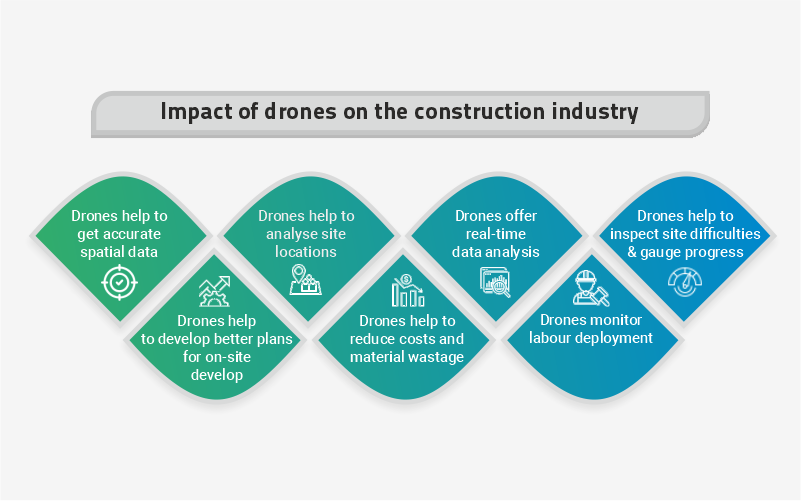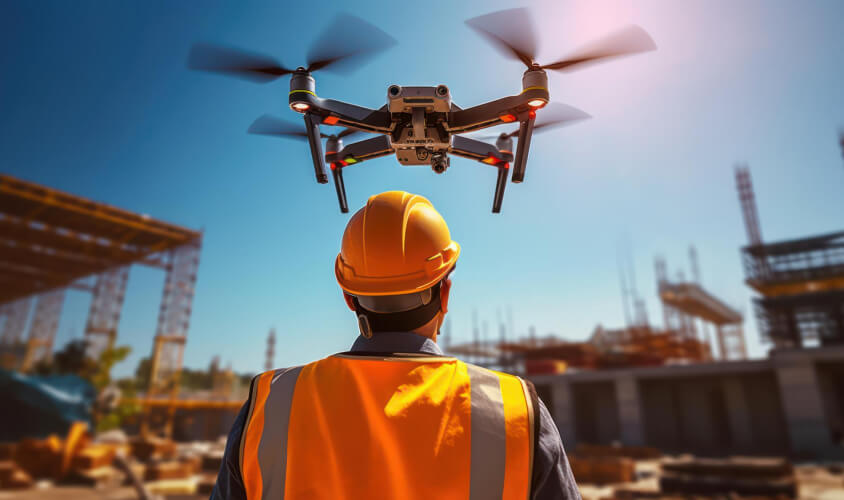Construction industry experts have long anticipated technology change to address problems like material waste and time and cost overruns in the industry. At these massive construction sites, the manual execution of every task has been replaced by the use of technological advances like robotics, machine control, telematics, and unmanned air vehicles (UAVs)/drones, ensuring maximum production while minimising material waste. Additionally, the complexity of the project sites, which are generally chosen for risky, monotonous, or dirty work, favours the use of drones.

Due to drones and UAVs, construction stakeholders have access to complete, exact, and accurate spatial data. Engineering tools can be used to analyse drone-derived data, and the data can even be superimposed on architectural drawings. The information gathered from each flight is examined using photogrammetry software to create digital elevation models (DEMs), orthophotos, and 3D point clouds. Numerous secondary data products, including shapefiles, contour lines, and raster products, are created when secondary data is entered into a geographic information system (GIS). The addition of spatial data to CAD/construction drawings also enables professionals to compare “as designed” to “as built,” allowing the detection of spatial mistakes far in advance of their execution on site.
Getting site data was traditionally done on foot or with manned aircraft before the development of aerial drones. Construction professionals have made use of drones to collect up-to-date photos as often as needed in real-time. Drones in construction allow contractors the option to monitor any difficulties, gauge progress, and develop better plans on-site by providing a site-specific view at a fraction of the cost. Several aspects of a construction project have generally been covered in this, including labour deployment, material wastage, site inspection, and an overall return on investment (RoI).
During the Covid-19 context, there has been a sharp rise in demand for remote site monitoring. Construction experts all around the world are gradually implementing drones and other unmanned aerial vehicles (UAVs) in various construction phases due to a number of operational and financial advantages. Using a fixed-wing drone system for an extended flight time, a very accurate topographic base map and orthorectified imagery are created. As a result, a lot of time and money are saved, and the final product is more attractive.
The upcoming trends driving the commercialization of drones in the construction industry are mostly due to drones with AI software powering them. A final inference to an approaching risk or error is provided by the application of AI to ensure that the unstructured aerial data collected by drones is stacked with relevant and organized data. The drone industry benefits from the convergence of cutting-edge technology (such as AI, AR/VR, and sensors) by providing a significant increase in the amount of data that can be used by the industry, reducing costs and enhancing safety while maximising performance.
About Author
Olivia Jones
Technology Specialist
Olivia is a highly skilled and experienced Technology Specialist with 10+ years of hands-on expertise in the rapidly evolving field of technology. She has a proven track record of successfully implementing and managing a wide range of technological solutions, ensuring optimal performance and efficiency. Olivia possesses a deep understanding of industry trends and emerging technologies, enabling her to provide strategic guidance and drive innovation within organizations. With a strong focus on problem-solving, she consistently delivers tailored solutions that align with business objectives while maximizing productivity and cost-effectiveness.
About SoftTech Engineers
A leading IT company (www.softtech-engr.com) facilitating business and technology transformation across the AEC industry through innovative software products and solutions. Equipped with 25+ years of deep domain expertise and industry knowledge, SoftTech has helped more than 4500 clients & government organizations, with more than 25000 users in India and around the world to gain a competitive edge and lead from the front in the industry.

